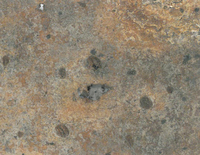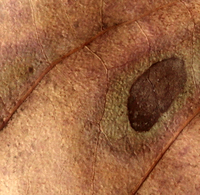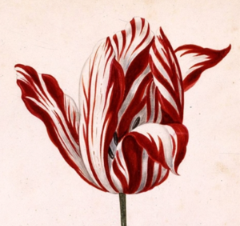Items
Site
The Medicine Chest
keywords is exactly
pattern recognition
-

Falling stars
Marine biologists studying whalesharks use the pattern-recognition technique, developed in 1986, that astronomers use to analyze data from the Hubble Space Telescope. Studying the spatial relationships between a whaleshark's spots form the basis for creating a unique identifier for each shark. -

#165317 Dipsy
In 2015, Conservation International scientists in Indonesia attached satellite transmitters to the dorsal fins of whale sharks to learn more about their migratory movements and diving behavior. Dipsy, a 4.57-meter male, spent much of his 17-month deployment in Triton Bay but also visited the Aru and Kei Islands – one of our first Kaimana whale sharks to explore the Arafura Sea – before returning to Kaimana. He hit a maximum depth of 625 meters. -

#165321 Yoda
In 2015, Conservation International scientists in Indonesia attached satellite transmitters to the dorsal fins of whale sharks to learn more about their migratory movements and diving behavior. Yoda had a lengthy 26-month deployment, spending all of that time in Cendrawasih Bay. The 4.83-meter male dove to a maximum depth of 1,375 meters, reaching the bottom of the bay at one of its deepest points. -

#151097 Fijubeca
In 2015, Conservation International scientists in Indonesia attached satellite transmitters to the dorsal fins of whale sharks to learn more about their migratory movements and diving behavior. At just 3 meters in length (about 10 feet), Fijubeca logged an impressive 9,000 kilometers (5,592 miles) during his deployment. He visited eight of the Bird’s Head Seascape's marine protected areas (MPAs), reaffirming the placement of MPAs as related to megafauna migratory routes. -

#168184 Sunbridge
In 2015, Conservation International scientists in Indonesia attached satellite transmitters to the dorsal fins of whale sharks to learn more about their migratory movements and diving behavior. Sunbridge was one of our first sharks tagged in Saleh Bay, Sumbawa, where he spent his entire 14-month deployment. Though this 6.23-meter male spent a fair bit of time on the surface, he frequently visited the bay's bottom at a maximum depth of 350 meters. -

#165905 Sebastian
In 2015, Conservation International scientists in Indonesia attached satellite transmitters to the dorsal fins of whale sharks to learn more about their migratory movements and diving behavior. Sebastian spent most of his 27-month deployment in Cendrawasih Bay but also recorded a visit to the Mapia atoll and ventured past Biak into PNG coastal waters. He eventually returned to Cendrawasih, where his tag's battery expired, having logged a maximum dive of 1,125 meters. -

Whalesharks (Fact/Fiction)
"With a crowd of pilot fish he prowled around the raft, and went on doing this for so long that that we plucked up courage. And when he lay to under the steering oar to scratch his back a bit, we thumped him in return, in a friendly way rather than otherwise, to see how he took it. But he liked it and came back and let himself be thumped three of four times. Then we gave him a bit of a jab with a harpoon, but we ought to not have done that, for he didn't like it and cleared off" (Hesselberg 1950: 48). -

Whalesharks (Fiction/Fact)
Whale sharks (Rhincodon typus) are the largest shark, and indeed largest of any fishes alive today. These gentle marine giants roam the oceans around the globe, generally alone. They only feed on plankton. In the Norwegian explorer, Thor Theyerdal's account of his journey by raft across the Pacific Ocean from South America to the Polynesian islands in 1947, the crew is visited by one of these curious and benign creatures: "In reality the whale shark went on encircling us for barely an hour, but to us the visit seemed to last a whole day. At last it became too exciting for Erik, who was standing at a corner of the raft with an eight-foot hand harpoon, and, encouraged by ill-considered shouts, he raised the harpoon above his head. As the whale shark came gliding slowly toward him and its broad head moved right under the corner of the raft, Erik thrust the harpoon with all his giant strength down between his legs and deep into the whale shark’s gristly head. It was a second or two before the giant understood properly what was happening. Then in a flash the placid half-wit was transformed into a mountain of steel muscles. We heard a swishing noise as the harpoon line rushed over the edge of the raft and saw a cascade of water as the giant stood on its head and plunged down into the depths. The three men who were standing nearest were flung about the place, head over heels, and two of them were flayed and burned by the line as it rushed through the air. The thick line, strong enough to hold a boat, was caught up on the side of the raft but snapped at once like a piece of twine, and a few seconds later a broken-off harpoon shaft came up to the surface two hundred yards away" . -

Pattern recognition
A display in Groote Schuur Hospital, Cape Town. The label reads: The History of Crockery Apartheid did more than separate the races. Parallel with the separate crockery for the different religions (Jewish = Blue; Muslim = Pink) was a range of separate crockery for the staff and patients of different races. Here are a few examples of this complex collection: Royal Blue: Jewish patients and staff (kosher) Dark Navy Blue: "European" patients Green: "European" staff Maroon: "Non European" patients Black: "Non European" staff Pink: Muslim patients and staff (halaal) These pieces of crockery are now part of our history and all patients are served meals in the standard rectangular crocker plate. -

Skin
I collected leaves from the gardens around Groote Schuur Hospital and gave them to UCT dermatologist Ranks Lehloenya for analysis. Using the strategy of directing insider focus to an outsider object, Lehloenya treated these specimens as sections of skin and read them accordingly, highlighting sections that showed signs of nummular eczema, acne, ageing, miliary tuberculosis and melanoma, to name a few (Liebenberg 2021: 277). This example was diagnosed as follows: "This section shows characteristics which could point at various causes. The darker raised sections could be blackheads as seen in acne (note the darker central area reminiscent of an open pore); villous hair cysts ( a condition in which hair follicles are trapped under the skin to form pimple-like structures with the hair giving a dark hue in the centre; syringomas (non-cancerous proliferation of sweat glands); infections such as chicken pox or miliary tuberculosis in which the infection spreads from the blood onto the skin (miliary mean it looks like a millet seed). It could also be metastatic melanoma that has spread from another area onto this skin". -

Skin
I collected leaves from the gardens around Groote Schuur Hospital and gave them to UCT dermatologist Ranks Lehloenya for analysis. Using the strategy of directing insider focus to an outsider object, Lehloenya treated these specimens as sections of skin and read them accordingly, highlighting sections that showed signs of nummular eczema, acne, ageing, miliary tuberculosis and melanoma, to name a few (Liebenberg 2021: 277). This example exhibits an annular pattern which could be an infection like a ringworm (fungus) and erythema migrans of Lyme’s disease; or inflammatory conditions like nummular eczema, erythema marginatum as seen in rheumatic fever and granuloma annulare. -

The broken tulip
"During the period known as tulipmania which transpired in the Netherlands during the 17th century, contract prices for bulbs of the recently introduced tulip reached extraordinarily high levels and then suddenly collapsed. Tulips that displayed a break in their colour reached prices far higher than those that didn’t. It wasn’t until 1920, after the invention of the electron microscope, that scientists discovered that the cause for this symphony of colour was a virus that spread from tulip to tulip by Myzus persicae, the peach potato aphid. Michael Pollan in The Botany of Desire, explains this phenomenon: “The colour of a tulip consists of two pigments working in concert — a base colour that is always yellow or white and a second, laid-on colour called an anthocyanin; the mix of these two hues determining the unitary colour we see. The virus works by partially and irregularly suppressing the anthocyanin, thereby allowing a portion of the underlying colour to show through — creating the magic of the broken tulip. A fact that, as soon as it was discovered, doomed the beauty it had made possible" (Pollan 2003: 97 in Liebenberg 2011: 92). -

Semper Augustus Tulip
Photo of Semper Augustus watercolour, captured whilst perusing the Pera Museum, Istanbul, 2013 -

Tobacco Mosaic Virus
During the late 19th century, tobacco farmers observed a strange occurrence on the leaves of their tobacco plants. A mosaic pattern of light and dark green (or yellow and green, in some instances) appeared on the leaves of their crops, the presence of which signalled the steady decline in the plant’s growth. Because of the lucrative nature of the industry, finding a treatment for this seemingly infectious disease became a priority, with many laboratories working to isolate the cause. Bacteria were recognised as the causative agents of many infectious diseases of plants and animals, including humans, in the second half of the 19th century – and the technique of filtration was developed to separate infectious agents from extracts or exudates in order to study these microbes. It was whilst utilising this technique that Dmitri Ivanovski, a Russian microbiologist working in the Crimea in 1890, made a surprising discovery. Using the Chamberland–filter made from porcelain and designed to trap ordinary bacteria, Ivanovsky discovered that the filtered sap from the diseased plants could continue to transfer the infection to healthy plants – an occurrence he attributed to an agent which must be an exceedingly small parasitic microorganism, invisible even under great magnification. It would take another 45 years before the visualisation of this subcellular entity would be formulated with the help of an electron microscope, but Ivanovksy, along with the Dutch botanist M.W. Beijerinck, who also and independently, isolated these microbes in his laboratory in 1898, are generally credited for the discovery of viruses. The disease which infected the tobacco plants would be aptly called the Tobacco Mosaic Virus, and its identification would signal the initiation of a field of study known as virology. -

Prrrip-Prrrip, Tseeeep!: the silence of birds’ eggs
"Birds are highly vocal creatures, their songs sound everyday in almost every habitat, even our concrete cities. These calls have been likened to the human capacity for speech, yet the faculty of language has, for most of history, been described as solely ‘human.’ Language forms one of several traits deployed to uphold the constructed divide between human and non-human animals. Oology – the collecting and documenting of wild bird eggs – was an obscure hobby and ‘science’ of the past. Collected eggs were pierced and ‘blown’ of their contents. The perfect shells, beautifully coloured with speckles and intricate patterns, were then placed in vast cabinet collections. Such a birds’ egg collection, collected in Southern Africa during the last half of the 20th century, forms the starting point of this exhibition. Through exploring language and communication in birds, this exhibition aims to create an affective environment for re-evaluating the collecting practices of the past (with its ties to the Euro-Western, human-centered perspective), and for re-imagining current natural history collections. It also aims to … poo-too-eee poo-too-eee, pa-chip-chip-chip per chick-a-ree. Ka-ha, ka-ha, kuh-uk-uk-uk! caw-caw-caw-caw-koodle-yah, loooooo-eee! Pa-chip-chip-chip, per-chick-a-ree!" Wall text of exhibition, Prrrip-Prrrip, Tseeeep!: the silence of birds’ eggs -

Dung beetles
Like ancient seafarers, dung beetles can navigate using the starry sky and the glow from the Milky Way. After locating a fresh pile of feces, dung beetles will often collect and roll away a large piece of spherical dung, then climb on their dung balls and dance around in circles before taking off. This dance is not one of joy, however; the insects are watching the sky to get their bearings. -

"I wonder if it remembers me..."
In Wes Anderson’s 2004 film, 'The Life Aquatic with Steve Zissou', Bill Murray plays the part of eccentric oceanographer, Steve Zissou. Zissou is both a parody of and homage to Jacques-Yves Cousteau, to whom the film is dedicated. The characters were inspired by The Great Gatsby and The Magnificent Ambersons, whilst the plot has been compared to Moby Dick. While filming a documentary, Steve’s partner Esteban du Plantier is eaten by a creature Zissou describes as a “Jaguar shark.” For his next project, Zissou orchestrates documenting the shark’s destruction. -

The Jaguar Shark
In Wes Anderson’s 2004 film, 'The Life Aquatic with Steve Zissou', Bill Murray plays the part of eccentric oceanographer, Steve Zissou. Zissou is both a parody of and homage to Jacques-Yves Cousteau, to whom the film is dedicated. The characters were inspired by The Great Gatsby and The Magnificent Ambersons, whilst the plot has been compared to Moby Dick. While filming a documentary, Steve’s partner and close friend, Esteban du Plantier, is eaten by a creature Zissou describes as a “Jaguar shark.” For his next project, Zissou orchestrates documenting the shark’s destruction.


